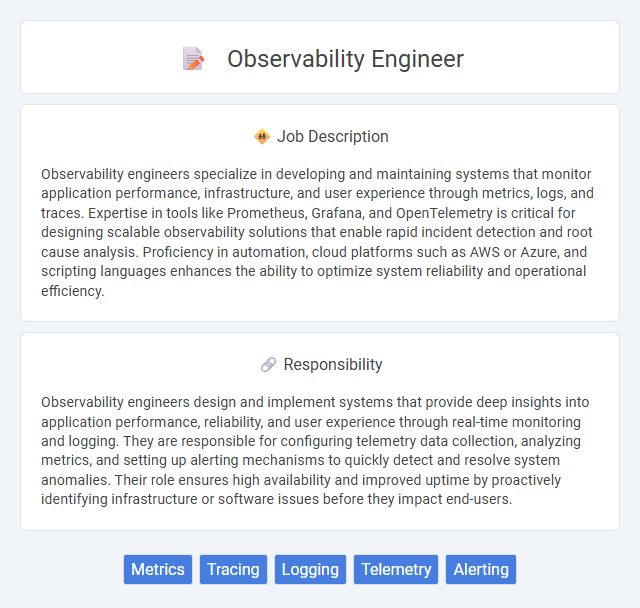
Observability engineers specialize in developing and maintaining systems that monitor application performance, infrastructure, and user experience through metrics, logs, and traces. Expertise in tools like Prometheus, Grafana, and OpenTelemetry is critical for designing scalable observability solutions that enable rapid incident detection and root cause analysis. Proficiency in automation, cloud platforms such as AWS or Azure, and scripting languages enhances the ability to optimize system reliability and operational efficiency.
Individuals with strong analytical skills and a passion for problem-solving are likely well-suited for an Observability Engineer role due to its demanding nature of monitoring and interpreting complex system data. Those comfortable working under pressure and skilled at collaboration across multiple teams may find this position aligns with their professional strengths. Conversely, people who prefer routine tasks or minimal technical interaction might struggle to thrive in this dynamic and high-responsibility environment.
Qualification
Observability engineers require expertise in monitoring tools such as Prometheus, Grafana, and ELK stack, alongside strong programming skills in Python, Go, or Java. Proficiency in cloud platforms like AWS, Azure, or Google Cloud and experience with container orchestration systems like Kubernetes are essential. Advanced knowledge of distributed systems, log analysis, and alerting frameworks enhances system reliability and performance optimization.
Responsibility
Observability engineers design and implement systems that provide deep insights into application performance, reliability, and user experience through real-time monitoring and logging. They are responsible for configuring telemetry data collection, analyzing metrics, and setting up alerting mechanisms to quickly detect and resolve system anomalies. Their role ensures high availability and improved uptime by proactively identifying infrastructure or software issues before they impact end-users.
Benefit
Observability engineers likely enhance system reliability by designing and implementing monitoring tools that detect issues early. Their work probably reduces downtime and improves overall system performance, benefiting both users and businesses. Companies may experience cost savings and increased operational efficiency as a result of effective observability practices.
Challenge
Observability engineer roles likely involve navigating complex system architectures to ensure seamless monitoring and troubleshooting, requiring deep expertise in metrics, logs, and tracing tools. The challenge often stems from integrating diverse data sources to create actionable insights that preempt system failures. Mastering scalable observability platforms and automating alerting mechanisms could be critical to maintaining optimal system performance.
Career Advancement
Observability engineers play a critical role in monitoring and improving system performance through advanced telemetry, analytics, and automated alerting tools. Mastery of cloud platforms, distributed tracing, and log aggregation technologies such as Prometheus, Grafana, and Jaeger enhances career growth and opens pathways to senior engineering or site reliability engineering (SRE) roles. Continuous skill development in infrastructure as code, Kubernetes, and AI-driven monitoring solutions significantly accelerates advancement opportunities within tech companies.
Key Terms
Metrics
Observability engineers specialize in designing and implementing metrics-based monitoring systems to ensure application performance and reliability. They leverage tools such as Prometheus, Grafana, and OpenTelemetry to collect, analyze, and visualize real-time metrics data, identifying bottlenecks and improving system health. Strong expertise in metrics aggregation, alerting rules, and SLA tracking is crucial to optimize infrastructure performance and reduce downtime.
Tracing
Observability engineers specializing in tracing implement distributed tracing solutions to monitor and analyze the flow of requests across microservices architectures, enabling precise identification of latency and bottlenecks. They utilize tools such as OpenTelemetry, Jaeger, and Zipkin to instrument applications, collect trace data, and visualize end-to-end transaction paths. Expertise in tracing is critical for enhancing system reliability, debugging complex interactions, and optimizing performance in cloud-native environments.
Logging
Observability engineers specialize in implementing and maintaining comprehensive logging systems that capture critical application and infrastructure data, enabling real-time monitoring and issue diagnosis. They design scalable log aggregation and analysis pipelines using tools like ELK Stack, Prometheus, and Grafana to ensure high data fidelity and quick retrieval. Mastery of log correlation and alerting mechanisms is essential to proactively detect anomalies and optimize system reliability.
Telemetry
Observability engineers specialize in designing and implementing telemetry systems that collect metrics, logs, and traces to monitor application performance and system health. They utilize tools such as Prometheus, Grafana, and OpenTelemetry to create scalable observability pipelines enabling proactive incident detection and resolution. Expertise in cloud-native environments and automation enhances the accuracy and granularity of telemetry data analysis.
Alerting
Observability engineers specialize in designing and managing alerting systems that detect anomalies and performance issues in real-time across complex infrastructures. They configure thresholds, create actionable alerts, and ensure seamless integration with monitoring tools like Prometheus, Grafana, and Datadog to minimize downtime and accelerate incident response. Expertise in alert fatigue reduction strategies and incident lifecycle management enhances system reliability and operational efficiency.
 kuljobs.com
kuljobs.com